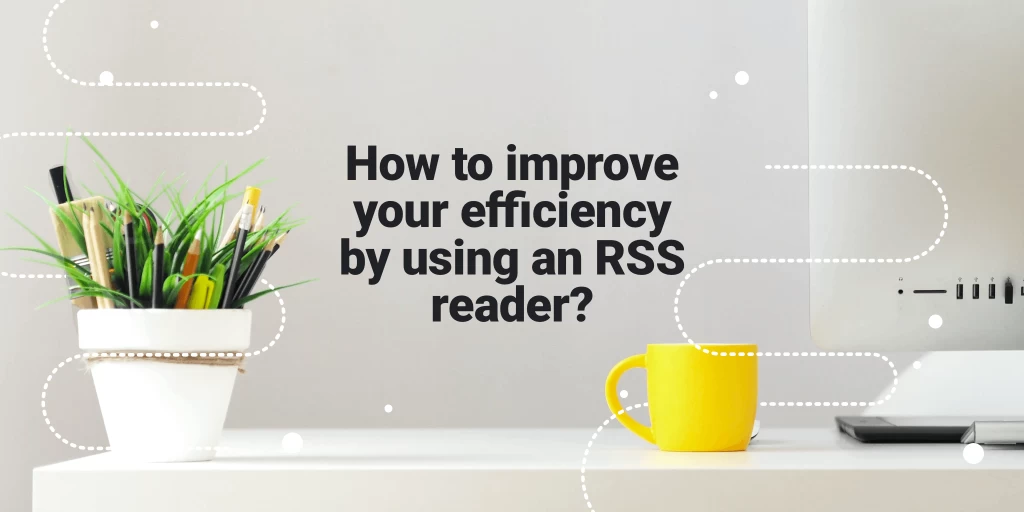How To Improve Your Efficiency By Using an RSS Reader?

It’s a little bit ridiculous to talk about work-life balance, when work has infiltrated every facet of our lives through our smartphones and social media presence. Workplace standards have shifted in a significant way towards continuous connectivity and expectation to be on top of developments in our professional field.
Alongside expected workplace responsibilities, you are tasked with digesting information in ever increasing volumes. How can you tell if you’re suffering from information overload? At the top of common scenarios is the overworked browser weighed down by an onslaught of open tabs, most of which you probably don’t remember why you’ve opened in the first place. You might also be familiar with the rush of endorphins at achieving inbox zero, a task many find impossible due to the influx of newsletters trickling in every hour.
Automation has been terraforming our professional lives for decades, so why not invite it into your reading habits by turning to RSS feed readers. RSS streamlines how you receive newsletter, blog articles and even social media posts.
But isn’t RSS over and done with? It’s true RSS has fallen out of the mainstream, but what works well can’t truly die so let’s dive into how a relic of the early Internet days can improve your overall efficiency in the workplace.
What is RSS?
Let’s turn back the hands of time to the proto-Internet when dial-up modems played static and the online world was fondly remembered as the zany Wild West – the late 90s. The idea for RSS has been floating in the ether since 1995, but the very first iteration was born in 1999, when Dan Libby and Ramanathan V. Guha succeeded in their attempt to restructure information from other websites into a standardized form. Much of the appeal of RSS lies in its simplicity, which is encoded in its name – “Really Simple Syndication”.
During the Blog Boom of the early 2000s, RSS became instrumental in empowering users to build their own lists of blogs they followed and as an extension build their own communities. Readers now could keep an eye on creators they loved in one web feed rather than have to individually check each website for new updates. Perhaps the most valuable function of RSS is that it delivers updates automatically to the feed, removing the necessity to refresh the same web pages over and over again.
It’s exactly syndication and curation that have contributed to the revival of RSS.
The RSS technology
No intrusive notifications, no ads, no pop-ups, no bells and whistles. RSS stands by its core concept – simplicity. RSS dresses down how you manage content, and it’s why it rose to prominence at all in the first place. You don’t need hours to figure out how to navigate an RSS reader, because it’s straightforward and made to be intuitive so even those without strong technological literacy can get around. But how does RSS actually work?
RSS creates a custom feed coded in XML, which dresses down every post to a few key elements – a title, a link to the full item and a description of what’s inside, which can take the form of either the first paragraph of the actual article or a custom summary. Either way, the idea is that you have these condensed updates in one place and can click on the post that interests you to read it in full. Users are then assisted in skimming through a higher number of news items and posts at a much faster pace. XML files are read by RSS aggregators and syndicated into an RSS feed.
RSS feeds and RSS feeders
Although not quite the standard anymore, websites maintain RSS feeds in XML files somewhere in their source code, which you can copy paste and add to your RSS feed reader. That’s in case you’re unable to locate the RSS feed button on the website, which is a bright orange icon located either in the header or at the bottom of a website. Once you subscribe to an RSS feed, that’s it – you receive every update in a unified feed through your RSS reader. Some websites with a high output such as newspapers and tech blogs might also offer sub-feeds dedicated to a narrow subject.
RSS feed readers are third-party clients, which translate XML files so that they’re accessible by end users. You have your choice between web-based feed readers, desktop applications and mobile applications. There’s an RSS feed reader for every person out there and it can be quite the journey to find the right fit for you, but it can be said of every modern RSS reader that you’re in complete control over how you organise, filter, archive and discover content.
How does an RSS feeder help you boost your efficiency?
Doesn’t RSS only work with old-school blogs? What’s the point of a technology, if it’s restricted? After all, most professionals pursuing careers in research-heavy fields turn to podcasts, YouTube channels, news sites and social media profiles to supplement their reading. The good news is that RSS has evolved significantly to accommodate these changes to our information diet, and there’s much more sense to syndicate all different feeds into a single location.
Modern RSS readers have a treasure trove of features to assist you during work hours. Feedly not only offers filtering options based on topics, but has powerful sharing options with integration to texting apps. Inoreader supports YouTube channels and filters duplicate stories, where more than one site covers the same story. This is especially useful, when following breaking news events.
Get the latest content
What magically improves when you switch to RSS is that you’re getting the latest content as it hits the Internet. It’s why RSS exists in the first place – to inform you when your favorite websites (and now YouTube channels, podcasts, and newsletters) post something new.
RSS removes several steps to arriving at relevant, interesting articles or breaking news. You can’t wait for a story to trend on Twitter to learn about it, just as you don’t have the time to browse at a leisurely pace anymore. Embrace RSS into your work day and enjoy how it smooths workflow so that you can efficiently go through your to-do list.
RSS will truly transform the way you discover and consume information.
Receive reliable news updates
The way we consume news has dramatically shifted with how traditional media has declined in great numbers throughout the last decade. Rather than newspapers, TV and radio (though still prominent in their own right), more and more people turn towards the Internet to learn news.
This is done either via news aggregator sites such as Google News or Yahoo! News or most commonly through Facebook and Twitter. Although initially convenient delivery systems (you can point to social media for the gradual decline of RSS in the first place), all these spaces have become dependent on algorithms that prioritize popularity and user-specific online habits. The end result is that you no longer receive unbiased news in a chronological order, but rather descend further down an echo chamber, which skewers your understanding of what’s happening in the world. Add in the proliferation of misinformation and it becomes near impossible to know for sure what is trustworthy news on your social media feed.
RSS feeds redirect control back into your hands as you bypass the algorithms that dictate what you see and subscribe to news outlets you trust. You receive news items as they’re published and you can apply this method to following specific journalists you trust to get their takes and works away from the general confusion of social media feeds.
Do not get overwhelmed with your emails
Email newsletters have earned the reputation of digital nuisance and clutter. What may seem like a good idea – receive posts from frequented sites in your inbox – backfires on a day-to-day basis. How many are the people who are irritated when they receive an email notification to turn out it’s a newsletter? I can’t be the only one, and some websites tend to abuse the frequency with which they send out newsletters; daily, if not multiple times a day. In the end, this invalidates the very notion of newsletters as time-conserving and useful.
Migrate newsletters to an RSS feeder and liberate your inbox for the emails that matter. Then you can rest knowing that whenever you receive an email alert, it’s for something that truly demands your attention. In those instances, where substituting a newsletter with an RSS feed is not possible (such as subscriptions to Substack newsletters), you can cheat a little and create your own. There’s a great tool called Kill the Newsletter, which converts email newsletters into RSS feeds.
Monitor brands, mentions, and keywords
Take the challenge to reduce your inbox to zero seriously and integrate your monitoring tasks with RSS readers to optimize your workload further. This is a viable strategy in those instances where you do not have the budget for a social media listening tool and instead rely on Google Alerts to monitor brand names, your name, keywords pertaining to your industry, campaign or product names that allow you see what’s being written about you and your company.
Rather than have alerts swarm your inbox, direct any results to an RSS feed instead. Subscribing not only declutters your inbox, but also organizes all alerts in a designated location available when you need them!
Look for jobs
Work efficiency doesn’t need to end with what you’re doing at your desk job. It can extend to what you’re doing to further your career, and this extends to job hunting. Where there are more than one job sites with active listings, there’s a way to introduce RSS as a tool to limit the time and effort you put into job research.
Subscribe to the feeds of the job sites like Indeed, We Work Remotely and Glassdoor and receive job openings in your RSS feed reader instantaneously. We all know that most often it’s first come, first served so you should be ready to pounce on a job offering as soon as it’s published. Where there are no RSS feeds available to subscribe, but a newsletter subscription option, you can always go to the Kill the Newsletter tool to create your own custom RSS feed. Or another way would be to head to RSS.app and request a custom feed for the URL you want to subscribe to.


